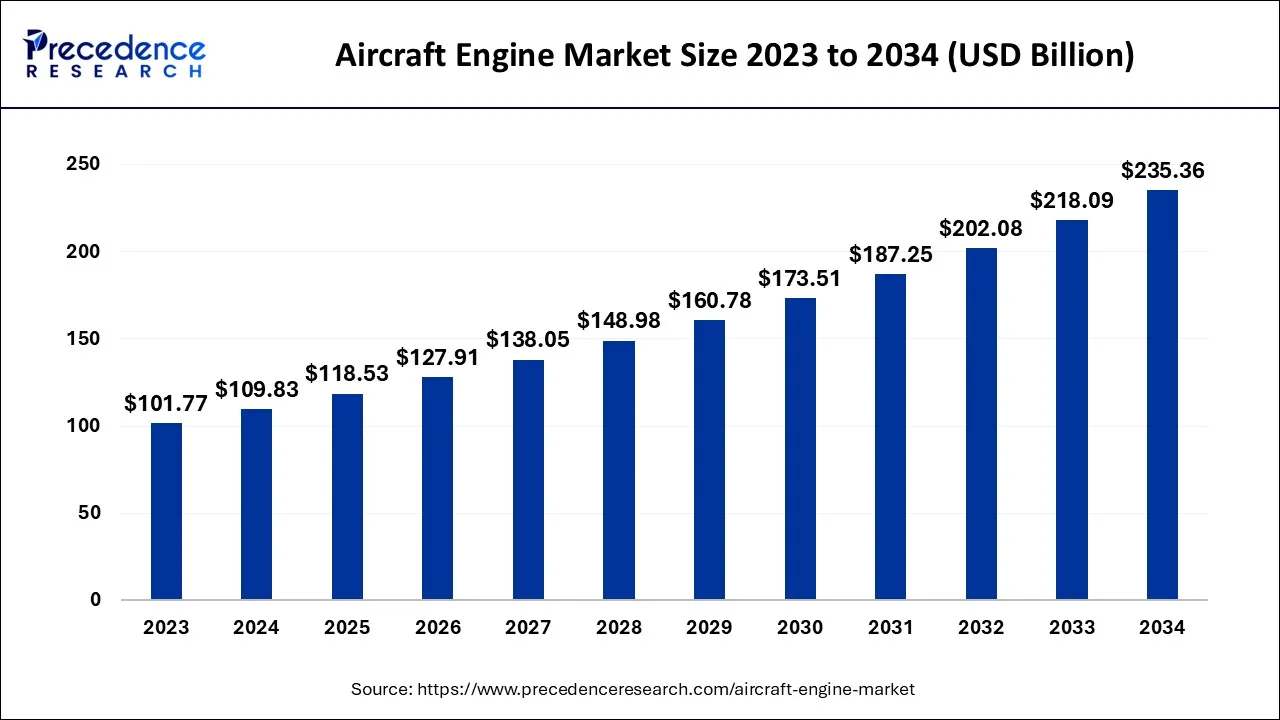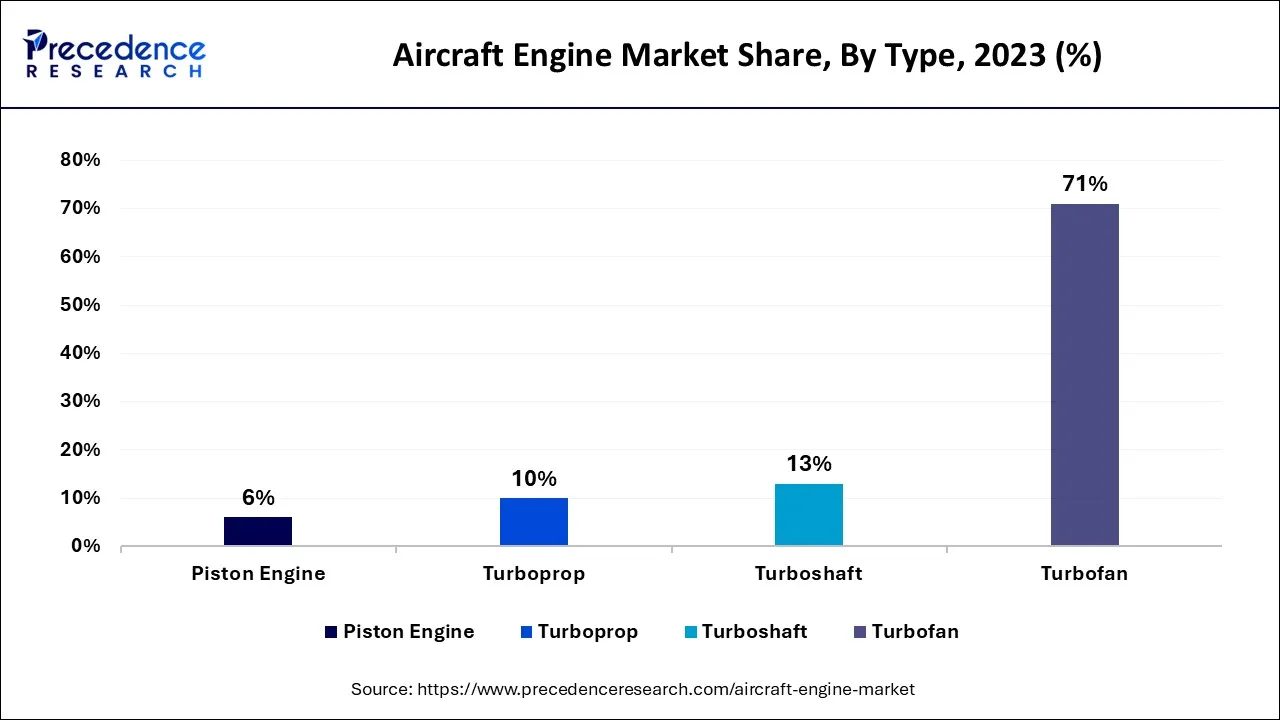March 2024
The global aircraft engine market size accounted for USD 109.83 billion in 2024, grew to USD 118.53 billion in 2025, and is expected to be worth around USD 235.36 billion by 2034, poised to grow at a CAGR of 7.92% between 2024 and 2034.
The global aircraft engine market size is expected to be valued at USD 109.83 billion in 2024 and is anticipated to reach around USD 235.36 billion by 2034, expanding at a CAGR of 7.92% over the forecast period from 2024 to 2034.

The component of the drive mechanism that produces mechanical power is an aircraft engine. A fan compresses the air inside an aircraft motor as it is drawn in from the front through a channel, mixed with fuel, and ignited. The air is then quickly and powerfully released from the back of the aircraft, which moves it forward. All aircraft are propelled by some form of mechanical engine, except a few hybrid or solar-powered models. A range of aircraft engines is offered for various aircraft end-uses, including passenger, cargo, military, and aviation applications.
The factor beneath the entire framework is provided by aircraft engines, which are items connected to the aircraft's impetus framework. These engines are in charge of the aircraft's display and are directly related to the operating effectiveness of the engine in terms of speed, impetus, push, and flying. The development of the overall Aircraft Engine Market in the upcoming years will be significantly impacted by the enormous interest in the advancement of a proficient aircraft engine. General Electric, Rolls-Royce, and Pratt & Whitney are the industry leaders.
| Report Coverage | Details |
| Market Size in 2024 | USD 109.83 Billion |
| Market Size by 2034 | USD 235.36 Billion |
| Growth Rate from 2024 to 2034 | CAGR of 7.92% |
| Largest Market | Asia Pacific |
| Base Year | 2023 |
| Forecast Period | 2024 to 2034 |
| Segments Covered | Type, Component, Platform, Technology, and Region |
| Regions Covered | North America, Europe, Asia-Pacific, Latin America, and Middle East & Africa |
Increasing air passenger traffic
Over the forecast period, it is anticipated that rising aviation passenger traffic will fuel the expansion of the aircraft engine market. Following a two-month pause until the reopening of domestic airline facilities in a graded fashion, carriers flew more than 70 lakh passengers during the period, increasing total air passenger traffic by 19% in 2020. Numerous airlines are updating their fleets with new aircraft to satisfy the demand for more seats in the air, which increases the need for new engines. According to the International Air Transport Association (IATA), there could be 8.2 billion travelers worldwide in 2037. As a result, the market for aircraft engines is expanding as more people travel by flight.
High maintenance cost
The forecasted development of the aircraft engine market is anticipated to be constrained by the high maintenance costs of aircraft engines. Cleaning and drying jet engine parts, inspecting the interiors and exteriors, disassembling the engine, repairing and replacing any damaged parts, and finally reassembly and testing the engine are all steps in the maintenance of aviation engines. Multiple tools are used to support skilled inspectors throughout the process, and other innovative techniques, like robots, can be used for maintenance. Refurbishing a small jet motor can cost between $200,000 and $300,000. Bigger engines will cost $3 million. As a result, the market for aircraft engines is constrained by the high expense of engine maintenance.
Integration of the 3D-printed parts
A major trend gaining traction in the aircraft engine market is the incorporation of 3D-printed components. To save money on fuel and materials, businesses are increasingly using 3D printing technology in aircraft engines and 3D printing-based manufacturing for the aviation industry. The first 777X jet, powered by twin GE9X engines, was completed by the American multinational aerospace behemoth Boeing, according to a January 2020 announcement from GE Aviation. Over 300 3D-printed parts can be found in the GE9X motors. The GE9X engine, which General Electric (GE) claims are 10% more fuel effective than the GE90 engine, was made possible by 3D printing. Thus, the integration of 3D-printed parts in an aircraft engine is expected to offer a lucrative opportunity for the growth of the aircraft engine market.
Based on the type, the global aircraft engine market is segmented into turboprop, turbofan, turboshaft and piston engines. The turbofan engine is expected to capture the largest market share over the forecast period due to its high fuel efficiency, which allows it to produce more thrust with almost the same quantity of fuel as the core. On the other hand, the turboprop segment is expected to grow at a substantial rate during the forecast period.

The turboprop engine was developed to operate more efficiently than the turbojet engine by adding the propelling function. The original goal of the turbojet motor was to fly at extremely high speeds and altitudes while performing better and more efficiently. Although their early climb and takeoff performance were not particularly good, when propellers were added to these turbojet engines, they were able to provide much better performance at medium speed and height as well. In conclusion, a turboprop engine blends the efficiency features of a turbojet and a propeller engine, in turn, driving the segment growth over the forecast period.
Based on the platform, the market is bifurcated into fixed-wing, rotary-wing and unmanned aerial vehicles. The fixed-wing segment is expected to dominate the market during the forecast period. A fixed-wing aircraft do not use wings to generate lift, so it has forward propulsion and is heavier than other kinds of aircraft. Fixed-wing aircraft generate lift using forward velocity. A fixed-wing aircraft's wings are not always stationary, and the pilot is not needed to fly the plane constantly. Simple instances of unmanned fixed-wing aircraft include kites and gliders, whereas manned fixed-wing aircraft include seaplanes and aeroplanes.
The fuselage, fixed wings, vertical and horizontal stabilizers, motor, and associated components are among the major components of a fixed-wing aircraft. An aeroplane without a tail or distinguishable fuselage is said to have flying wings. Blended wing bodies produce more lift and less friction when the wings are integrated into the body.
Based on the technology, the market is segmented into conventional and hybrid. The conventional segment is expected to capture a significant market share over the forecast period. The primary participants in the market for conventional aircraft engines are currently the key players in the market for aircraft engines. However, many new players are bringing in novel developments to provide aircraft engines that give operators more efficiency and are more dependable than the current aircraft engines in response to the growing demand for more functionality from atypical aircraft engines. In the vast majority of airplanes, the engines are either gas turbines or pistons. Turbofan, turboprop, turboshaft, and others are some of the common kinds of aircraft engines. These conventional aircraft engines are used in a broad range of aircraft, including military aircraft, helicopters, wide-body and narrow-body commercial aircraft, and UAVs. As a result, the demand for conventional aircraft engines will increase along with the demand for commercial and defense aircraft in the aviation sector.
The Asia Pacific is expected to grow at the fastest rate over the forecast period. The growth in the region is attributed to the strong demand for domestic air travel in emerging economies such as India and China. For instance, IATA (International Air Transport Association) estimates that in 2022, air traffic in India will be 85.7% higher than in 2019. While domestic ASK (Available Seat Kilometers) rose 30.1% from the prior year, the nation's RPKs (Revenue Passenger Kilometers) increased by 48.8% from 2021. Similarly, The DGCA, India's aviation regulator, recently disclosed that 123.2 million people in India traveled in 2022. This was a 47% increase over the 2021 traveler’s totals. Vistara and IndiGo exceeded 2019 levels.
In contrast, Vistara flew 11.35 million passengers last year, a substantial increase over the 7.44 million it carried in 2019. IndiGo carried nearly 68 million passengers, a million more than it did in 2019. In addition, countries are increasing their investments to strengthen their aerial capabilities by buying cutting-edge aircraft and replacing their outdated aircraft as a result of geopolitical tensions in the area. By 2035, the Indian Air Force hopes to fill the gap between the number of squadrons it currently has and the necessary number by purchasing 450 fighter jets for use on the country's northern and western frontiers. These fleet modernization plans will probably increase demand in the upcoming years for cutting-edge, lightweight, fuel-efficient motors.
North America is expected to grow at a significant rate over the forecast period. The growth in this region is attributable to the presence of major players such as GE Aviation and Honeywell International Inc. Moreover, the growing defense investments are the major factor that penetrates the market expansion in the region. The total amount spent on the US defense in 2021 increased by 2.9% to USD 801 billion. The US spent USD 801 billion, or roughly 38% of all military expenditures globally, on its military in 2021, according to the Stockholm International Peace Research Institute. (SIPRI).
A further increase of 5.6% from the budget projections for 2021 was seen in the updated budget estimates for 2022, which came to a total of USD 782 billion. For the purchase of aircraft for the Air Force, the budget sets aside about USD 15.7 billion. A budget of approximately USD 169.5 billion has also been asked by the Air Force for FY 2023, of which USD 18.5 billion will be used to buy aircraft. Thus, the aforementioned facts support the market growth in the region.
Segments Covered in the Report
By Type
By Component
By Platform
By Technology
By Geography
For inquiries regarding discounts, bulk purchases, or customization requests, please contact us at sales@precedenceresearch.com
No cookie-cutter, only authentic analysis – take the 1st step to become a Precedence Research client
March 2024